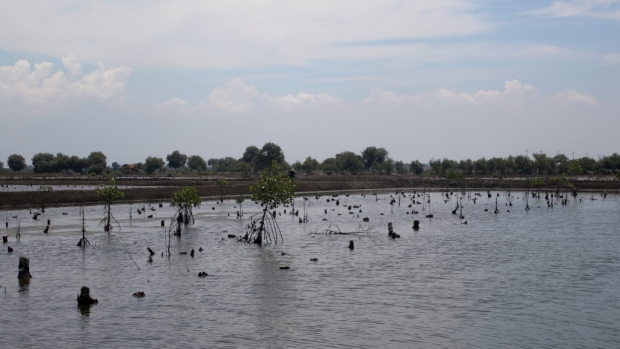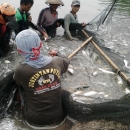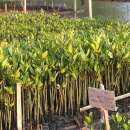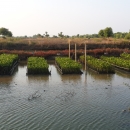Grants :: Small Grant Facilities :: Improving Fishing Community Well-Being at Cangkring Village, Cantigi Subdistrict, Indramayu District through Milkfish Aquaculture and Community-Based Mangrove Revegetation
Improving Fishing Community Well-Being at Cangkring Village, Cantigi Subdistrict, Indramayu District through Milkfish Aquaculture and Community-Based Mangrove Revegetation

One of the mangrove revegetation sites, Cangkring Village, Cantigi, Indramayu, Java © MFF IUCN, 2015
Objectives
To protect coastal areas from abrasion, flood, and seawater intrusion through mangrove ecosystem rehabilitation, community awareness and livelihood activities
Background
Mangrove deforestation along coastal areas of Cangkring village for fish ponds and settlement development has led into massive abrasion, regular flooding, and sea water intrusion, and resulted in the loss of local community income during both high dry and rainy seasons.
Target beneficiaries
Women's group and fisher community in Cangkring village.
Outputs
- 400,000 mangrove seedlings were planted with 80% growth rate to rehabilitate 4 ha area in Laut (sea) Cilik;
- Community group was trained on organizational management;
- Milkfish aquaculture was chosen as an alternative livelihood or the source of sustainable income by the local fishers so they didn’t have to depend on season and catch any longer where production cycle period was relatively short. On February 2015, the first production resulted in 650 kg milkfish. The price per kg was IDR 16,000. On the second production (April 2015), 1 ton milkfish were harvested, and the price was still the same, 16,000/kg;
- Women’s group received training on fishery-based food processing / small-scale business.
Accomplishments and challenges
- The following training activities had been implemented, prior to the implementation of the rehabilitation and livelihood activities:
- Training on mangrove planting techniques, including establishment of nursery, planting and maintenance (May 2014), attended by 32 villagers (22 males and 10 females), and 2 resource persons from District Forestry Office;
- Training on organization management, facilitated by Bina Swadaya Foundation (end August 2014), participated by 35 villagers (18 males and 17 females). This included discussion on the proposed activities for both male and female group. Additional training on financial management was held at Bina Swadaya Foundation office, Depok (mid-September 2014), participated by 6 group members (3 males and 3 females);
- Training on home-based vegetable growing (end September 2014), participated by 15 women group members, trained by district’s field extension officer;
- Training on fish-based home industry (mid Dec 2014) provided by district’s fishery field extension officer, participated by 16 group members (10 females and 6 males);
- A total of 45,000 seedlings had been planted in nurseries (112.5% of originaly proposed 40,000 seedlings), consisted of Rhizopora stylosa, Rhizopora mucronata, Rhizopora apiculata and Bruguiera gymnorrhiza, with very high average growth success (>95%). A 40,000 of which had been planted in restoration area with high growth success (83%). All seedlings were planted on the 4 hectares of accreted land, locally known as “Laut Cilik” (literally mean “small sea”). This was much lesser than the originally proposed 10 ha, partly due to the availability of accreted land to be planted as well as the optimum planting distance of 1 x 1 m for 40,000 seedlings. In addition, the community group argued that this lesser area will be more feasible to be maintained, and larger area will be planted beyond MFF period, as part of regular group work plan;
- The following activities have been implemented aimed on the improvement of community’s livelihood:
- Pilot aquaculture: 1st distribution of 10,000 milk fish in 2 hectares of fish ponds (May 2014) had been harvested on 1 February 2015, yielded 614 kg for a total value of Rp.9.210.000 (Rp.15,000/kg). The 2nd distribution of 6,000 milk fish on end November 2014, while the 3rd distribution of 4,700 milk fish on mid-January 2015;
- The small-scale home industry on fish-based products (including nugget, meat ball, shredded fish and bone-less fish). The products were marketed locally. Further assistance was still required to improve quality and packaging of the product.
- Mangrove planting and nursery sites were located far from community settlement which Required more resources for monitoring and maintenance;
Contributions to cross-cutting themes
- Climate change and disaster risk reduction
Around 10 ha mangrove ecosystems are rehabilitated
- Gender equality
The members of a women's group received training to start home-based businesses so they can have their own income.
- Knowledge management and communications
Training on mangrove management (nursery techniques, potting, fertilizing, and so forth) attended by 30 participants (20 males and 10 females) and training on organizational management.
Lessons Learned
- In the case that nursery site is located far away from community settlement and rehabilitation site, it requires more resources for maintenance and monitoring;
- In relation to livelihood activities/the initiation of small scale businesses, training on income generation followed by the production might take some time (going through some trials and errors). It is hard to estimate percentage of the benefit per month from the activities that instant, and the project period is also relatively short (10-12 months). The most reasonable outputs than can can be expected from these activities are knowledge sharing to the direct beneficiaries (groups involved) on how to process fish and other products to become commodities with more economic value and entrepreneurial spirit.
Country
Location
Cangkring Village, Cantigi, Indramayu, Java
Topic
Duration
11th Apr 2014 to 10th Apr 2015
MFF Grant Amount
IDR 180,000,000
Implementing Partner
Bina Swadaya Foundation
Wisma Hijau, Jalan Mekarsari Raya 15, Mekarsari-Cimanggis
Depok 16952, West Java
and Community Based Organization Pancer Pindang
Desa Cangkring Blok Pancer Pindang Rt 07 Rw 04
Kecamatan Cantigi-Kabupaten Indramayu, West Java
Email address: binaswadaya@binaswadaya.org


